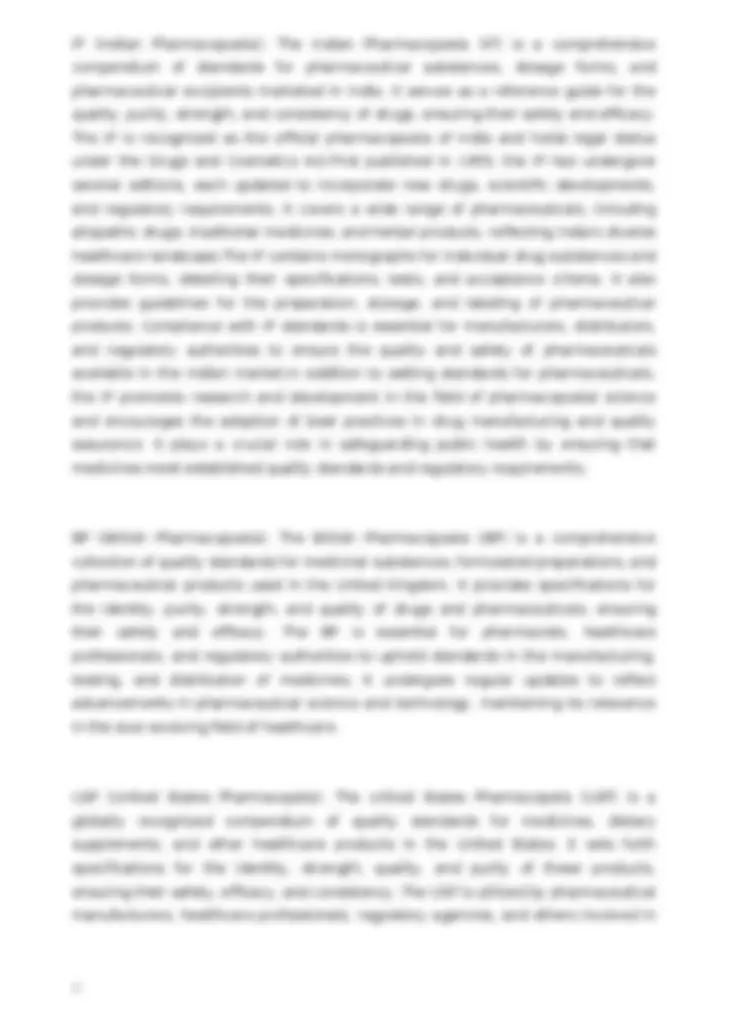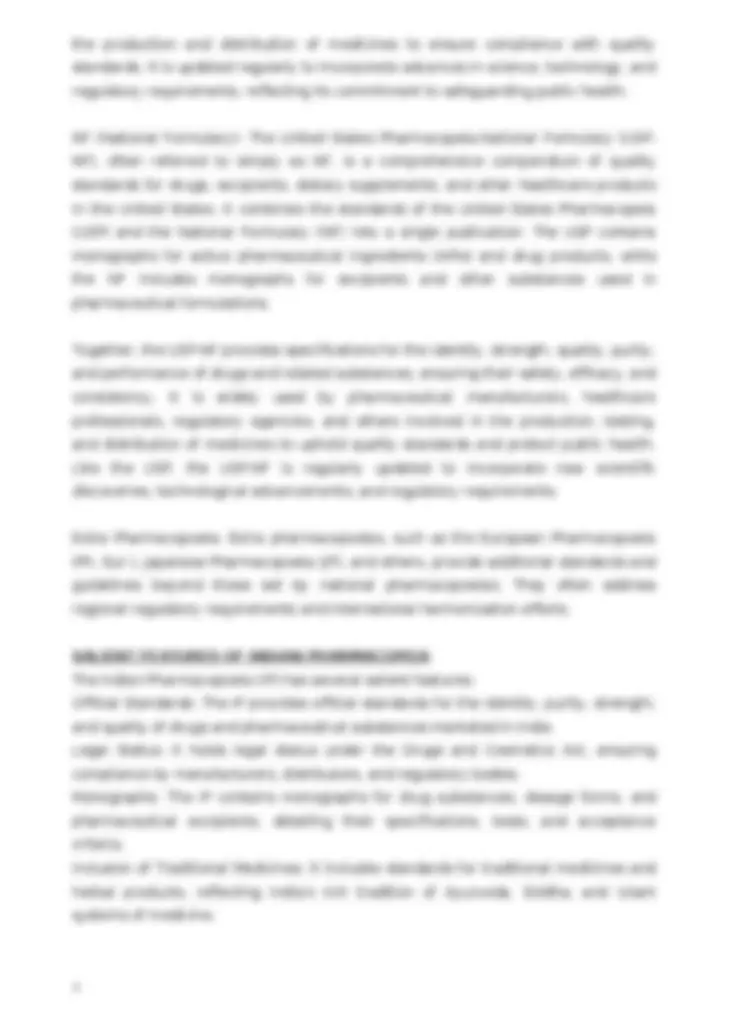





Study with the several resources on Docsity

Earn points by helping other students or get them with a premium plan


Prepare for your exams
Study with the several resources on Docsity

Earn points to download
Earn points by helping other students or get them with a premium plan
Community
Ask the community for help and clear up your study doubts
Discover the best universities in your country according to Docsity users
Free resources
Download our free guides on studying techniques, anxiety management strategies, and thesis advice from Docsity tutors
A brief study notes of chapter 1 pharmaceutics in this notes, history of pharmacy profession in India. Introduction to IP, BP, USP and NF Salian features of Indian Pharmacopoeia Are described
Typology: Lecture notes
1 / 5

This page cannot be seen from the preview
Don't miss anything!




The profession of pharmacy in India has a rich history dating back centuries. Traditional Indian medicine systems like Ayurveda, Siddha, and Unani have long emphasized the use of herbs and natural substances for healing, and pharmacists played a crucial role in preparing and dispensing these remedies.During British colonial rule, Western medicine and pharmacy practices were introduced to India. The first pharmacy education institution, the Madras College of Pharmacy, was established in 1891. Subsequently, several other pharmacy colleges were founded across the country.After independence, the pharmacy profession continued to evolve. The Pharmacy Act of 1948 regulated the profession, emphasizing the importance of education, registration, and practice standards. Over the years, pharmacy education in India has undergone significant development, with the establishment of more colleges, universities, and regulatory bodies like the Pharmacy Council of India (PCI).Pharmacy education in India typically includes undergraduate (B.Pharm), postgraduate (M.Pharm), and doctoral (Ph.D.) programs. The curriculum covers various aspects of pharmaceutical sciences, including pharmacology, medicinal chemistry, pharmaceutics, pharmacognosy, and pharmacy practice.In recent years, there has been a growing emphasis on research and innovation in pharmacy education, with institutions collaborating with industries and research organizations to address healthcare challenges and develop novel drugs and therapies. Additionally, there has been a shift towards incorporating technology and digital tools into pharmacy education to keep pace with advancements in the field. Overall, the history of pharmacy in India reflects a journey of adaptation, growth, and professionalisation, with pharmacy education playing a vital role in shaping the future of the profession. History of pharmacy practice in india The practice of pharmacy in India has a rich history intertwined with the evolution of healthcare systems and medicinal traditions. Traditional Indian medicine systems like Ayurveda, Siddha, and Unani have deep roots in the country, and pharmacists played a significant role in preparing and dispensing herbal remedies based on these systems.During the medieval period, the Mughal Empire further enriched India's pharmaceutical landscape by introducing Persian and Arabic medicinal practices. This period saw the establishment of dispensaries and the emergence of Hakims, practitioners of Unani medicine, who contributed to the development of pharmacy practice.With the arrival of Europeans, particularly the Portuguese, Dutch, French,
and British, in India, Western medicine and pharmacy practices were introduced. The British East India Company's establishment of trading posts and colonial rule further shaped the trajectory of pharmacy in India.In the 19th century, the British government recognized the need for regulation and standardization of pharmaceutical practices. The Pharmacy Act of 1948 was a significant milestone in the regulation of pharmacy practice in India. It established the Pharmacy Council of India (PCI) and set guidelines for the education, training, and registration of pharmacists.Over the years, pharmacy practice in India has evolved to encompass various sectors, including community pharmacy, hospital pharmacy, industrial pharmacy, regulatory affairs, and academia. Pharmacists play a crucial role in ensuring the safe and effective use of medicines, counseling patients on medication management, and promoting public health initiatives.In recent decades, there has been a growing emphasis on pharmaceutical care and clinical pharmacy services, with pharmacists actively involved in medication therapy management, disease prevention, and health promotion activities. The profession continues to evolve in response to advances in healthcare technology, changes in regulatory frameworks, and emerging healthcare challenges.Overall, the history of pharmacy practice in India reflects a dynamic journey of adaptation, innovation, and professionalization, with pharmacists playing a vital role in the nation's healthcare ecosystem. PHARMACY AS CAREER •Pharmacy offers diverse career options in areas like community pharmacies, hospitals, industry, research, academia, and regulatory affairs. •Pharmacists help people by ensuring safe and effective use of medications, providing counseling, and collaborating with other healthcare professionals. •Opportunities for specialization through postgraduate education exist in clinical pharmacy, pharmaceutical sciences, and regulatory affairs. •Pharmacists can also work in research and development, contributing to the discovery and testing of new drugs and therapies. •Entrepreneurial opportunities exist in owning pharmacies, consulting, or healthcare startups focusing on medication management and digital health solutions. •Overall, pharmacy is a rewarding career choice with opportunities for professional growth and making a positive impact on patient care and healthcare innovation PHARMACOPEIA Pharmacopoeias are compendia of standards for the quality, purity, strength, and consistency of medications and their ingredients. Here's a brief introduction to each:
the production and distribution of medicines to ensure compliance with quality standards. It is updated regularly to incorporate advances in science, technology, and regulatory requirements, reflecting its commitment to safeguarding public health. NF (National Formulary): The United States Pharmacopeia-National Formulary (USP- NF), often referred to simply as NF, is a comprehensive compendium of quality standards for drugs, excipients, dietary supplements, and other healthcare products in the United States. It combines the standards of the United States Pharmacopeia (USP) and the National Formulary (NF) into a single publication. The USP contains monographs for active pharmaceutical ingredients (APIs) and drug products, while the NF includes monographs for excipients and other substances used in pharmaceutical formulations. Together, the USP-NF provides specifications for the identity, strength, quality, purity, and performance of drugs and related substances, ensuring their safety, efficacy, and consistency. It is widely used by pharmaceutical manufacturers, healthcare professionals, regulatory agencies, and others involved in the production, testing, and distribution of medicines to uphold quality standards and protect public health. Like the USP, the USP-NF is regularly updated to incorporate new scientific discoveries, technological advancements, and regulatory requirements. Extra Pharmacopoeia: Extra pharmacopoeias, such as the European Pharmacopoeia (Ph. Eur.), Japanese Pharmacopoeia (JP), and others, provide additional standards and guidelines beyond those set by national pharmacopoeias. They often address regional regulatory requirements and international harmonization efforts. SALIENT FEATURES OF INDIAN PHARMACOPEIA The Indian Pharmacopoeia (IP) has several salient features: Official Standards: The IP provides official standards for the identity, purity, strength, and quality of drugs and pharmaceutical substances marketed in India. Legal Status: It holds legal status under the Drugs and Cosmetics Act, ensuring compliance by manufacturers, distributors, and regulatory bodies. Monographs: The IP contains monographs for drug substances, dosage forms, and pharmaceutical excipients, detailing their specifications, tests, and acceptance criteria. Inclusion of Traditional Medicines: It includes standards for traditional medicines and herbal products, reflecting India's rich tradition of Ayurveda, Siddha, and Unani systems of medicine.
Updates and Revisions: The IP is regularly updated and revised to incorporate new drugs, scientific advancements, and changes in regulatory requirements, ensuring relevance and accuracy. Harmonization with International Standards: Efforts are made to align IP standards with those of other pharmacopoeias, promoting harmonization and facilitating global trade. Promotion of Quality Assurance: By setting quality standards, the IP promotes the production of safe, effective, and consistent pharmaceutical products, safeguarding public health. Compliance Requirements: Compliance with IP standards is essential for obtaining marketing approval from regulatory authorities and for ensuring the quality and safety of pharmaceutical products in the Indian market.